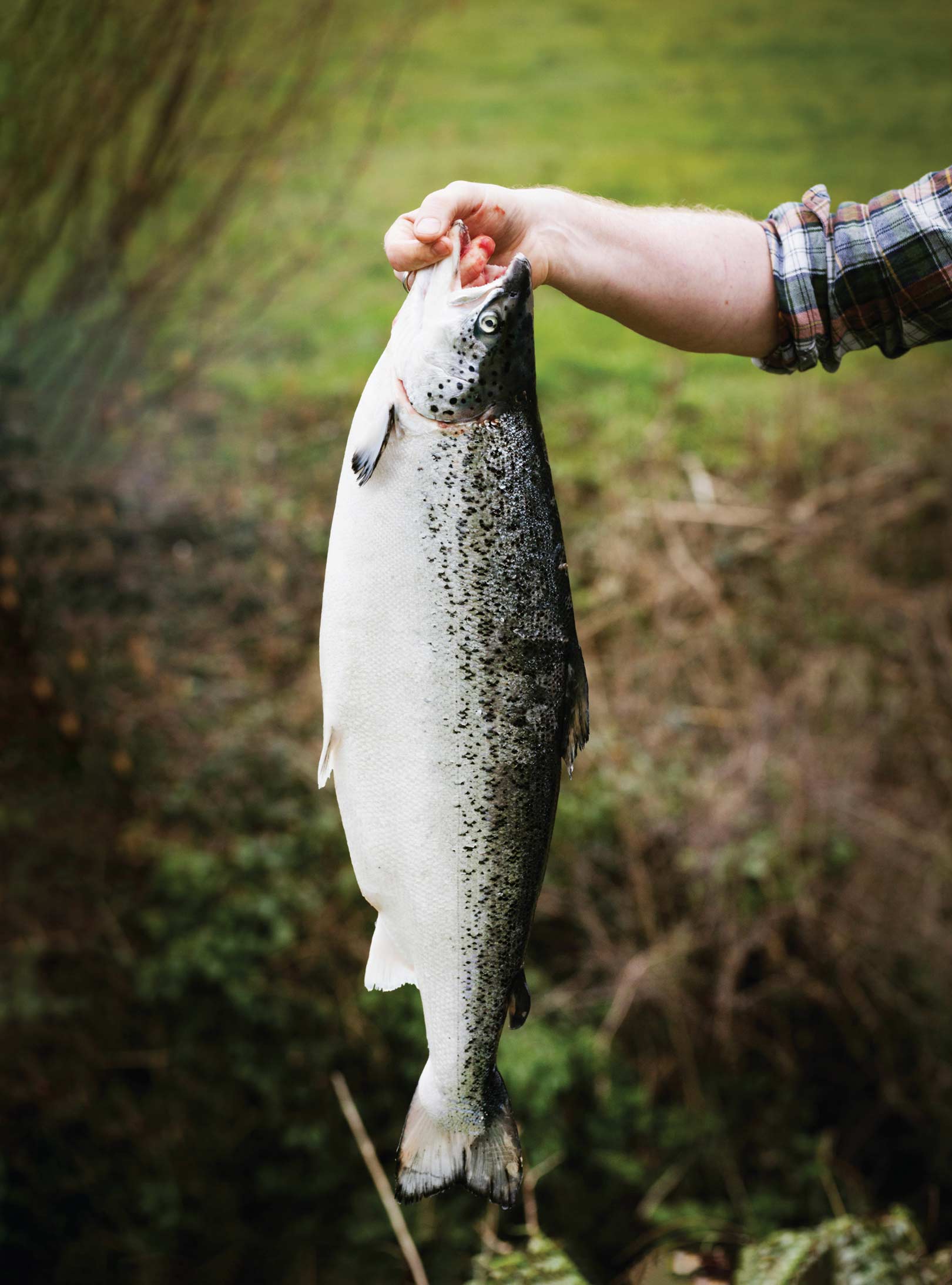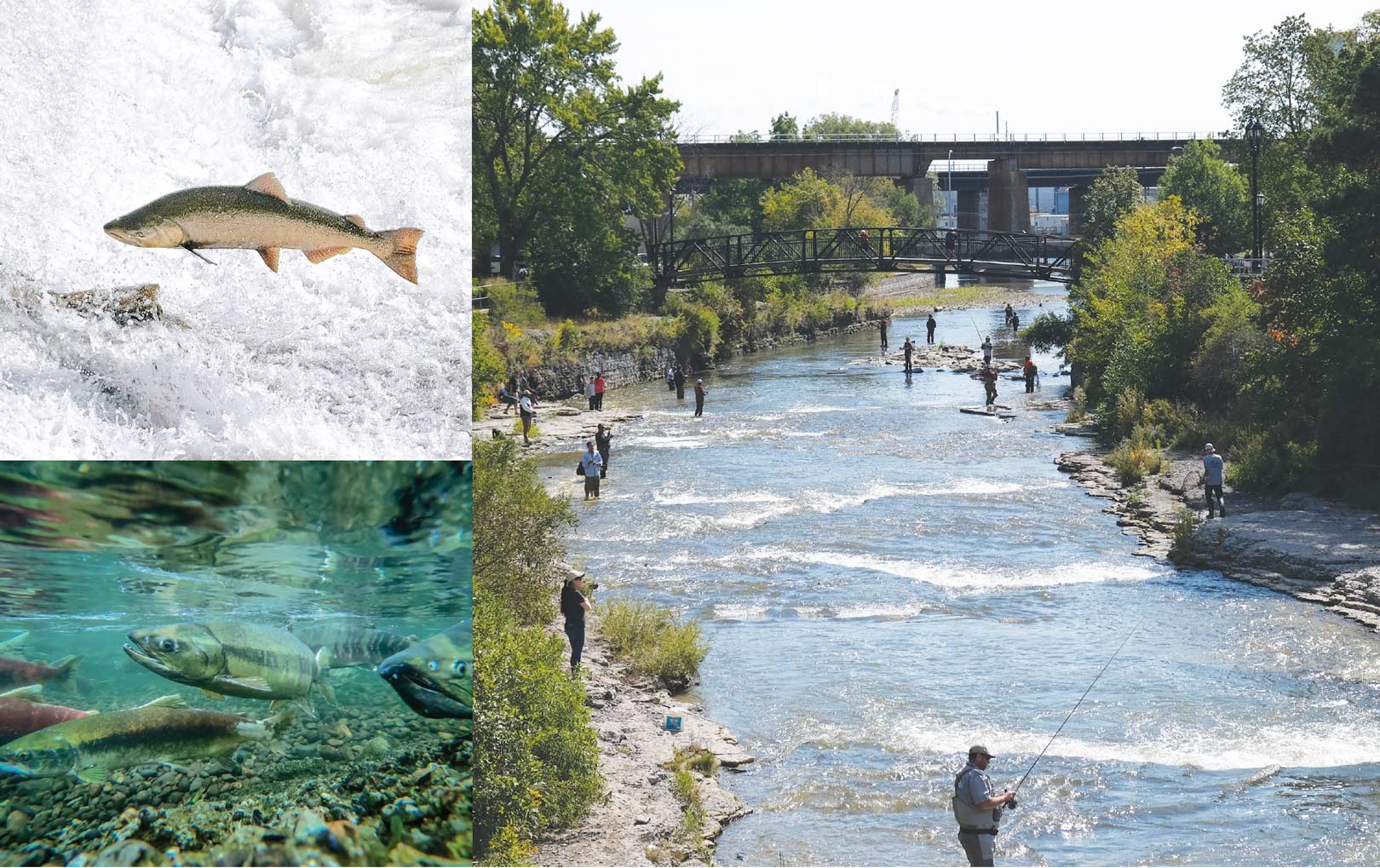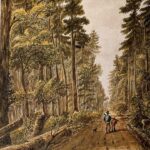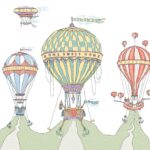

photograph top left by Lee Higginson, right courtesy Port Hope Tourism
This fall as the salmon fight their way up the Ganaraska to their spawning grounds, the growing crowds of anglers fighting for position along the riverbanks and rapids are causing chaos and concern for the future of the fishery.
The salmon are running. Tens of thousands of salmon are on their way from Lake Ontario to their natal waters in the Ganaraska River, a mass migration triggered by signals that include the change of seasons, the cooling water and the phase of the moon.
The annual return of Chinook and other salmon is a natural wonder worthy of celebration. But in recent years the spectacle has perhaps become too much of a good thing. The easy pickings of fish, as they wait in the shallows to pass through the bottleneck at Corbett’s Dam, just south of the 401 in Port Hope, has attracted hordes of anglers to the river’s lower reaches through the town where the practices of some have drawn criticism.
These practices have tarnished a very positive story – the establishment of a self-sustaining salmon run on the Ganaraska River. Before European colonization, Atlantic salmon thrived in Lake Ontario, returning for millennia to spawn in the waterways feeding it. For pioneers the fishery seemed inexhaustible. Settlers in the 1830s used torches and spears to collect as many as ten ninety-kilogram barrels of salmon in a single night.
By 1896 the species was extinct in Lake Ontario, the victim of a perfect storm of factors including overfishing, the construction of mill ponds that powered industry but blocked the ancient migration routes, and the wholesale clearing of central Ontario’s forests.
Waterways such as the Ganaraska slowly returned to health through the following century thanks in large part to reforestation efforts intended to stabilize waterflows and mitigate extreme spring runoffs, which flooded downtown Port Hope on a number of occasions. The return of salmonid fish species to Lake Ontario began in the late 1800s, when rainbow trout – an import from Western Canada – were introduced.
More western salmon came in the latter half of the 1900s when coho and Chinook were stocked in an effort to control alewives, which are native to the Atlantic Ocean. They were first noted in Lake Ontario in 1873 and became widespread in the Great Lakes basin after the opening of the Welland Canal. Once in the lakes, the invading alewives became a problem, consuming the early life stages of native species such as yellow perch and lake trout.
The coho and Chinook, which are saltwater fish, weren’t expected to survive without restocking. But today most of the salmon caught in the waters of eastern Lake Ontario are a self-sustaining population, emerging from eggs in spawning grounds in rivers such as the Ganaraska, spending their adult lives in Lake Ontario, where they’re prized by sport fishermen, and returning to their natal rivers to spawn and die. Between 65 and 90 percent of the fish coming up the Ganaraska this fall will be Chinooks, with coho and rainbow trout forming the next largest groups. A small number of brown trout and native Atlantic salmon, stocked in recent decades in an effort to re-establish a sustainable population, will also make the run.
Last year more than 30,000 salmon were counted on the fishway at Corbett’s Dam, just south of the 401. This fall the run is expected to be even bigger. The 2023 fall run was the largest observed since monitoring began in 2017. The Ministry of Natural Resources is expecting “significant returns of two large groups of Chinook salmon born in 2021 and 2022. While final counts will determine if this year sets a record, the recent increase is a positive indicator of sustainability of the fishery and Lake Ontario ecosystem.”
LIKE SHOOTING FISH IN A BARREL
Corbett’s Dam, constructed in the 1850s by the Molson family to power a sawmill, a brewery and a distillery, presents a major obstacle between the lake and 30 kilometres of unobstructed river to where the salmon do most of their spawning. Only 1,000 to 2,000 salmon per day can pass through the dam’s fishway, which was constructed in the early 1970s, while many wait below the dam in a small sanctuary area. The MNR says that this is not big enough to accommodate and protect the thousands of migrating fish.
Downstream from Corbett’s Dam, flood control modifications to the river make fish migration even more complicated. The salmon accumulate in engineered step pools separated by shallow limestone stretches of water. According to the MNR, the fish confined in the pools “become concentrated and are highly visible and vulnerable, with no means of escape.” People have even been seen grabbing them with their hands. While a few fish may spawn below the dam, the area is not ideal for reproduction.
By 1896 Atlantic salmon were extinct in Lake Ontario, the victim of a perfect storm of factors including overfishing, the construction of mill ponds that powered industry but blocked the ancient migration routes, and the wholesale clearing of Central Ontario’s forests.
ANGLING FOR CHANGE
Sean Carthew is an avid angler and organizer of Port Hope’s annual Run Salmon Run event, which aims to put a positive spin on the run with family activities, music and food. He has observed both the epic salmon numbers and the angling activity it attracts. “Some years the river is just black with salmon.”
While Carthew acknowledges that anglers have been coming to the run for decades, in the past “it was annoying but not a big conversation.” In recent years, he says, it has grown worse and worse as anglers hear about the run through social media, bringing upwards of 30,000 into Port Hope over the five or so weeks of the spawning season. “Right through town, it’s just packed with fishermen.”
Carthew says that a lot of people are using the salmon as a food source. “Others are whipping out the eggs and throwing the fish on the banks.” The roe, sold as bait, is “big business.”
“They’re taking them out by coolers-full. They’re netting them. They’re snagging them. They’re picking them out of the water. It’s not fishing. I think the fish should have a chance to get upriver. It’s a black eye.”
Carthew’s response to the incidents of the 2023 run which included anglers catching over their limits, using illegal methods to catch fish, littering and gutting fish for their eggs then leaving their carcasses to rot, was to start an online petition calling for a closure of the salmon run fishery. It quickly gathered 13,000 signatures.
In light of the problem and the public response it generated, the Ministry of Natural Resources has proposed closing the fishing season in the protected section from the Jocelyn Street Bridge downriver to the CNR track between September 1 and October 14 and opening an extended late fall season from October 15 to December 31.
The MNR’s proposed regulations coincide with Carthew’s ideas. “It’s a super smart proposal that is fair to all, including the salmon. I believe it will, for the most part, stop the ridiculousness that happens along the river during the peak of the salmon run and offer something in return for the fishermen that do follow the rules by extending the season with late fall fishing. They take away six weeks of fishing during a time when the salmon are just too exposed and give back 10 weeks of fishing.”
Carthew’s original position – to close the fishery during the run – has evolved to include alternatives such as better enforcement of fishing regulations and littering bylaws. He also suggests sections of the river could be designated as different zones, some for education – which would not permit fishing, and others for barbless hook and fly fishing. “We should turn it into a positive.”
“They’re taking them out by coolers-full. They’re netting them. They’re snagging them. They’re picking them out of the water. Others are whipping out the eggs and throwing the fish on the banks. It’s not fishing. I think the fish should have a chance to get upriver.” SEAN CARTHEW
ENFORCEMENT VERSUS CLOSURE
Jason Whyte is not as enthusiastic about the new regulations. He has been involved with the Ganaraska River fishery for some five decades, as an angler and a volunteer with activities such as an annual “fish lift” to help salmon over Corbett’s Dam. He agrees with some of Carthew’s views, in particular the need for greater enforcement of fishing regulations but feels the river should be kept open to anglers.
He says it’s “not an issue of too many anglers but rather that certain people see it as a food source and a money source. They want to take that salmon home and don’t care how they get it.” He notes that a large fish could be worth $200 at supermarket prices at a time when “people have a hard time making the grocery bill.”
“Enforcement last year was the main kerfuffle,” says Whyte. He points out that in 2015 Port Hope trained municipal police officers so they could be deputized as conservation officers, an approach that successfully policed the anglers. Then during Covid, the fishery was closed. Last year, says Whyte, the municipality didn’t have enough trained police and its bylaw enforcement officer wasn’t working weekends.
He describes himself as “extremely torn” about the proposed regulation changes. “It’s an enforcement issue. The town dropped the ball big time the last two years.” He feels the changes will just move anglers to other rivers. “I am glad they are protecting a wild population but if it was their sole desire they would monitor other rivers too. This is just fixing a people problem in the town of Port Hope.”
Only 1,000 to 2,000 salmon per day can pass through the dam’s fishway, which was constructed in the early 1970s, while many wait below the dam in a small sanctuary area. The MNR says that this is not big enough to accommodate and protect the thousands of migrating fish.
AN UPSTREAM BATTLE
Port Hope Deputy Mayor Claire Holloway Wadhwani acknowledges the policing problems of recent years. She says a Ganaraska Salmon Working Group which included the municipality, its police service, the MNR, the Ontario Federation of Anglers and Hunters (OFAH) and the Ganaraska Region Conservation Authority used to meet during the mid-teens but stopped meeting regularly during Covid.
She attributes the lack of trained police officers last year to personnel turnover, a shortfall that is being corrected with more training and extended bylaw enforcement. Holloway Wadhwani says that the Ontario Federation of Anglers and Hunters is also planning to add a higher profile to its educational activities.
“This year they’re taking it down to the river in a more concentrated way” through a “Respect the River” campaign in which OFAH volunteers will be wearing marked T-shirts and monitoring angler activity.
The fall salmon run, says Holloway Wadhwani, is about more than just fishing. “It’s so spectacular just to watch. It brings out a lot of people who are not fishermen.”
With new rules in the offing it’s uncertain what the Ganaraska fall fishery will look like in the future, although it appears likely some combination of restrictions to angling and greater enforcement will bring relief to public complaints about activities associated with the run. What is certain is that the salmon are back, and in greater numbers than ever.
Run, salmon, run.
If you want to fish the Ganaraska you’ll need an Outdoors Card and a licence, which can be obtained online at ontario.ca. If you are under 18 or over 65, you don’t need a licence but you do need to carry ID that verifies your age. Be sure to check when the river is open.
Story by:
Norm Wagenaar



